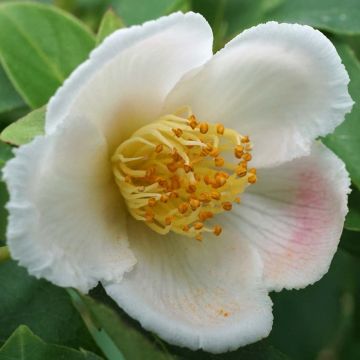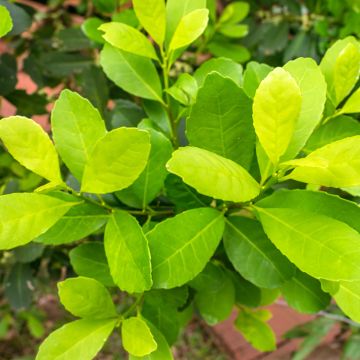

Stewartia pteropetiolata
Stewartia pteropetiolata
Stewartia pteropetiolata
This item cannot be shipped to the selected country
Delivery charge from €5.90
More information
Schedule delivery date,
and select date in basket
This plant carries a 24 months recovery warranty
More information
We guarantee the quality of our plants for a full growing cycle, and will replace at our expense any plant that fails to recover under normal climatic and planting conditions.
From €5.90 for pickup delivery and €6.90 for home delivery
Express home delivery from €8.90.
Does this plant fit my garden?
Set up your Plantfit profile →
Description
Stewartia pteropetiolata is an Asian bush related to camellias, mainly known by collectors because it is very rare in cultivation. It has evergreen, dark green and glossy foliage. This dark vegetation enhances its white spring flowers. The bush has an upright habit with layered growth. It is not very hardy and requires acidic, moist to wet soil. It will only thrive in open ground in the mildest areas.
Stewartia belongs to the small family of Theaceae, mainly known for camellias, with the most famous non-ornamental representative being the Tea Plant (C. sinensis). There are about ten species of Stewartia according to classifications, almost all of them native to Asia, except for two found naturally in North America.
Stewartia pteropetiolata is native to Yunnan (a province in southern China with a predominantly subtropical climate) and Vietnam, and it is frost-sensitive from around -5°C to -6°C. In its natural habitats, it forms a large bush of 6 m or more in height, reaching up to 15 m as a tree, with a fairly straight trunk covered with a beautiful fissured grey bark. It produces rather inconspicuous white flowers that turn yellow as they wither and fall to the ground, while sometimes they remain on the plant and develop into red fruits. It is found growing in forests in mountainous areas, at altitudes ranging from 1200 to 2600 m. It was discovered by Irishman Augustine Henry, a passionate botanist and great provider of seeds and plant samples from the Kew Gardens botanical garden in London, and introduced to Europe in 1912.
In the few areas where it can be grown in open ground, it will form an upright bush with slow growth. With age, the plant will reach 6 m in height and 4 m in width. Its main characteristic is its evergreen foliage, which has led some botanists to classify it in a separate genus (Hartia sinensis). Furthermore, the leaves are carried on curiously winged petioles, hence its specific name (pteron = wing in Greek). The leaf blade has an elliptical shape and measures from 6 to 13 cm in length and 2.5 to 5 cm in width. The petiole is short, 1 to 1.5 cm long, and equipped with a 3 mm wide wing. The leaves are dark green and their surface is glossy, creating a pleasant contrast with the young branches which are yellowish at first, then reddish-purple before turning grey when mature. The dark vegetation allows for a better appreciation of the flowering, which would otherwise be relatively inconspicuous. The white flowers, resembling those of some camellias (but smaller), only measure 3 cm in diameter. They are solitary and bloom in April and May. The centre of the corolla is occupied by numerous stamens whose bases are fused, forming a sort of tube. Their dark yellow tips give relief to the single flower, resting on oval, reddish-purple sepals. When fertilised, the flower produces an ovoid capsule fruit, 1.5 to 2 cm long and 1 to 1.5 cm wide, composed of five small lobes.
This Stewartia will grow in very mild oceanic climates, such as the one prevailing in Cornwall, England and elsewhere in Europe, it is also found along Lake Maggiore, which has a particular microclimate. It must be recognised that the species is not the most attractive in the genus, and it will mainly interest enthusiasts and collectors. A Eucryphia x intermedia Rostrevor will offer a similar-looking flowering but with slightly larger and more abundant flowers, as well as better hardiness. However, Stewartia pteropetiolata has the advantage of being rarer and exuding a certain romantic charm, coupled with an exotic appearance. You can integrate it into a bed alongside Embothrium coccineum, or Chilean Fire Tree, another curiosity with more or less evergreen green foliage and exceptionally flamboyant red flowering.
Report an error about the product description
Plant habit
Flowering
Foliage
Botanical data
Stewartia
pteropetiolata
Theaceae
China
Other Stewartia
Planting and care
Stewartia pteropetiolata thrives in acidic or possibly neutral, non-limestone soil. It prefers humus-bearing and moist soils that are well-drained, light, and fertile. Preferably choose a semi-shaded exposure, although this species tolerates the sun better than others, so you can grow it in full sun as long as the roots stay moist. If these conditions are not met, it will languish and never reach its full potential. It should be protected from cold and drying winds, as the plants are sensitive to frost, from -5/-6°C.
This only allows it to be planted in the ground in the mildest coastal areas provided there is a sufficiently cool and moist environment, which is often a challenge. The bush should not be planted too deep, with the top of the root ball covered by 3 cm. In winter, cover it with a 5 to 7 cm thick mulch composed of leaf compost and shredded bark. During dry periods, water to maintain soil moisture, as this bush dislikes drought and heat waves.
Planting period
Intended location
Care
This item has not been reviewed yet - be the first to leave a review about it.
Shrubs for semi-shade
Haven't found what you were looking for?
Hardiness is the lowest winter temperature a plant can endure without suffering serious damage or even dying. However, hardiness is affected by location (a sheltered area, such as a patio), protection (winter cover) and soil type (hardiness is improved by well-drained soil).

Photo Sharing Terms & Conditions
In order to encourage gardeners to interact and share their experiences, Promesse de fleurs offers various media enabling content to be uploaded onto its Site - in particular via the ‘Photo sharing’ module.
The User agrees to refrain from:
- Posting any content that is illegal, prejudicial, insulting, racist, inciteful to hatred, revisionist, contrary to public decency, that infringes on privacy or on the privacy rights of third parties, in particular the publicity rights of persons and goods, intellectual property rights, or the right to privacy.
- Submitting content on behalf of a third party;
- Impersonate the identity of a third party and/or publish any personal information about a third party;
In general, the User undertakes to refrain from any unethical behaviour.
All Content (in particular text, comments, files, images, photos, videos, creative works, etc.), which may be subject to property or intellectual property rights, image or other private rights, shall remain the property of the User, subject to the limited rights granted by the terms of the licence granted by Promesse de fleurs as stated below. Users are at liberty to publish or not to publish such Content on the Site, notably via the ‘Photo Sharing’ facility, and accept that this Content shall be made public and freely accessible, notably on the Internet.
Users further acknowledge, undertake to have ,and guarantee that they hold all necessary rights and permissions to publish such material on the Site, in particular with regard to the legislation in force pertaining to any privacy, property, intellectual property, image, or contractual rights, or rights of any other nature. By publishing such Content on the Site, Users acknowledge accepting full liability as publishers of the Content within the meaning of the law, and grant Promesse de fleurs, free of charge, an inclusive, worldwide licence for the said Content for the entire duration of its publication, including all reproduction, representation, up/downloading, displaying, performing, transmission, and storage rights.
Users also grant permission for their name to be linked to the Content and accept that this link may not always be made available.
By engaging in posting material, Users consent to their Content becoming automatically accessible on the Internet, in particular on other sites and/or blogs and/or web pages of the Promesse de fleurs site, including in particular social pages and the Promesse de fleurs catalogue.
Users may secure the removal of entrusted content free of charge by issuing a simple request via our contact form.
The flowering period indicated on our website applies to countries and regions located in USDA zone 8 (France, the United Kingdom, Ireland, the Netherlands, etc.)
It will vary according to where you live:
- In zones 9 to 10 (Italy, Spain, Greece, etc.), flowering will occur about 2 to 4 weeks earlier.
- In zones 6 to 7 (Germany, Poland, Slovenia, and lower mountainous regions), flowering will be delayed by 2 to 3 weeks.
- In zone 5 (Central Europe, Scandinavia), blooming will be delayed by 3 to 5 weeks.
In temperate climates, pruning of spring-flowering shrubs (forsythia, spireas, etc.) should be done just after flowering.
Pruning of summer-flowering shrubs (Indian Lilac, Perovskia, etc.) can be done in winter or spring.
In cold regions as well as with frost-sensitive plants, avoid pruning too early when severe frosts may still occur.
The planting period indicated on our website applies to countries and regions located in USDA zone 8 (France, United Kingdom, Ireland, Netherlands).
It will vary according to where you live:
- In Mediterranean zones (Marseille, Madrid, Milan, etc.), autumn and winter are the best planting periods.
- In continental zones (Strasbourg, Munich, Vienna, etc.), delay planting by 2 to 3 weeks in spring and bring it forward by 2 to 4 weeks in autumn.
- In mountainous regions (the Alps, Pyrenees, Carpathians, etc.), it is best to plant in late spring (May-June) or late summer (August-September).
The harvesting period indicated on our website applies to countries and regions in USDA zone 8 (France, England, Ireland, the Netherlands).
In colder areas (Scandinavia, Poland, Austria...) fruit and vegetable harvests are likely to be delayed by 3-4 weeks.
In warmer areas (Italy, Spain, Greece, etc.), harvesting will probably take place earlier, depending on weather conditions.
The sowing periods indicated on our website apply to countries and regions within USDA Zone 8 (France, UK, Ireland, Netherlands).
In colder areas (Scandinavia, Poland, Austria...), delay any outdoor sowing by 3-4 weeks, or sow under glass.
In warmer climes (Italy, Spain, Greece, etc.), bring outdoor sowing forward by a few weeks.














































